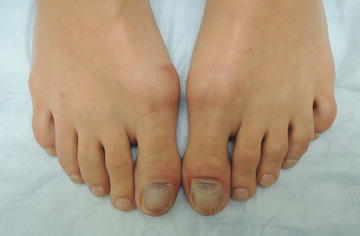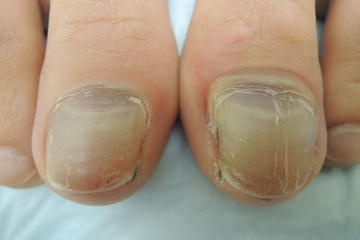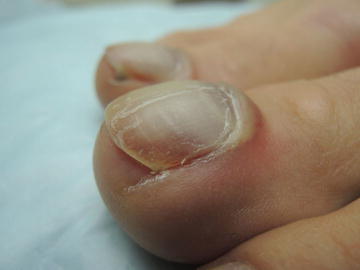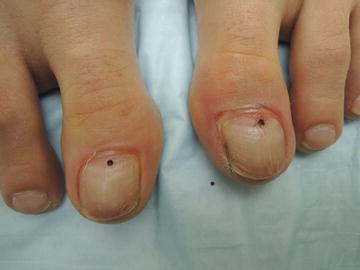, Corinna Eleni Psomadakis2 and Bobby Buka3
(1)
Department of Family Medicine, Mount Sinai School of Medicine Attending Mount Sinai Doctors/Beth Israel Medical Group-Williamsburg, Brooklyn, NY, USA
(2)
School of Medicine Imperial College London, London, UK
(3)
Department of Dermatology, Mount Sinai School of Medicine, New York, NY, USA
Keywords
TraumaTraumatic injuryNail bedBruiseHematomaSubungualTrephination
Fig. 20.1
Dusky maroon subungual color to the proximal nail bed bilaterally

Fig. 20.2
Trephination of the hematoma is typically recommended for release of pressure and amelioration of pain if >50 % of the nail bed involved

Fig. 20.3
Exsanguination extending to the lateral and proximal nail folds

Fig. 20.4
Appearance just after trephination performed with heated paperclip
Primary Care Visit Report
A 33-year-old female with no past medical history presented with pain in both hallux toenails lasting 3 days. Three days prior, the patient had been walking in high heel shoes for 7–8 h. The morning after that, she noted that her bilateral hallux toenails were purple and red beneath the nails , and that the nails were elevated off the nail beds . There was no pain when she walked barefoot, but any pressure from socks or shoes irritated the area. The patient was a modern dancer who danced barefoot and was concerned because she “needed her toes.” She was otherwise well.
Vitals were normal. On exam, bilateral hallux toenails with purple-hued nails were noted, with bilateral nails displaced superiorly, and bilateral cuticles appearing vesicular with clear fluid. Periungual and cuticle areas were non-tender. There was slight tenderness to palpation of bilateral nail beds with minimal pressure.
These were treated as subungual hematomas. The heated paperclip method was used to decompress the hematomas with a trephination procedure. The nail areas were cleaned with betadine, a paperclip was heated with a lighter until it was red hot, and then the heated end of the paperclip was placed onto each of the patient’s hallux toenails in order to form small holes in them. As the heated paperclip was advanced, it melted the nail beneath it. When the paperclip was almost all the way through the nail, In order to avoid burning or puncturing the nail beds, an unheated 23-gauge needle was used to finish making the holes through the entire depth of the nails. With some light pressure applied to the nails, about 1 cc of serosanguinous fluid flowed from the hole in each toenail. The patient felt immediate relief. Bacitracin and gauze were applied to allow the fluid to continue to drain. The patient was also advised to soak her toes in warm water to allow for further drainage.
Differential Dx
Subungual hematoma
Melanoma
Acral lentiginous melanoma
Subungual nevus
Onychomycosis
Full access? Get Clinical Tree








